The Deficit Myth 001
I recently finished Stephanie Kelton’s book The Deficit Myth and I’m going to create a series of blog entries considering the material of the book. In doing so, I will liberally be quoting the book as part of my goal is to consider and digest my highlights from the text.
Kelton’s goal is to have us understand Modern Monetary Theory and how if embraced, it can help us create a better society. Kelton asks “What would it look like if the government overcame the deficit myths [the concept of having to maintain a household budget] and started budgeting like a currency issuer instead of pretending that it needs to pay for its spending just like the rest of us?” (pg. 42)
Although I think that we should all read this book (though it can be a bit repetitive), I’m going to copy the main points of the United States federal deficit myths that need to be debunked. These points are in the introduction and are given a chapter each:
First Myth:
The idea that the United States federal government needs to budget like a household is pernicious… “MMT demonstrates that the federal government is not dependent on revenue form taxes or borrowing to finance its spending and that the most important constraint on government spending is inflation.” pg. 9
Second Myth:
“It is possible for the government to spend too much. Deficits can be too big. But evidence of overspending is inflation, and most of the time deficits are too small, not too big.” pg.9
Third Myth:
Deficits will burden the next generation. Ronald Reagan was one of the wort perpetrators of the myth that we would saddle our children with too much debt, because it’s powerful political rhetoric. “As a share of gross domestic product (GDP), the national debt was at its highest – 120% – in the period immediately following WWII. Yet, this was the same period during which the middle class was built, real media family income soared, and the next generation enjoyed a higher standard of living without the added burden of higher tax rates… Increasing the deficit doesn’t make future generations poorer, and reducing the deficit won’t make them any richer.” pg.9
Fourth Myth:
“…deficits are harmful because the crowd out private investment and undermine long-term investment… government deficits eat up some of the dollars that would otherwise have been invested in private sector endeavors that promote long-term prosperity. We will see why the reverse is true – fiscal deficits actually increase private savings – and can easily crowd-in private investments.” pg. 10
Fifth Myth:
“Deficits make the United States dependent on foreigners [China and Japan as they hold large quantities of U.S. debt]… this is a fiction that politicians wittingly or unwittingly propagate, often as an excuse to ignore social programs desperate need of funding. Sometimes this myth has used the metaphor of irresponsibly taken out a foreign credit card. This misses the fact that the dollars aren’t originating from China. They’re coming from the U.S. We’re not borrowing from China so much as we’re supplying China with dollars and then allowing them to trade those dollars in for a safe, interest-bearing asset called a U.S. treasury. There is absolutely nothing risky or pernicious about this. If we wanted to, we could pay off the debt immediately with a simple keystroke.” pg.10
Sixth Myth:
“Entitlements are propelling us toward a long-term fiscal crisis. Social Security, Medicare, and Medicaid are the supposed culprits… Our government will always be able to meet future obligations because it can never run out of money. The money can always be there. The question is, What will that money buy? Changing demographics and the impacts of climate change are real challenges that could put stress on available resources.” pg.11
Kelton ends the introduction with a call to arms:
“The fact that 21 percent of all children in the United States live in poverty- that’s a crisis. The fact that our infrastructure is graded at a D+ is a crisis. The fact that inequality today stands at levels last seen during America’s Gilded Age is a crisis. The fact that the typical American worker has seen virtually no real wage growth since the 1970s is a crisis. The fact that forty-four million Americans are saddled with $1.7 trillion in student loans debt is a crisis. And the fact that we ultimately won’t be able to ‘afford’ anything at all if we end up exacerbating climate change and destroy the life on this planet is perhaps the biggest crisis of them all.” pg.11
“These are real crises. The national deficit is not a crisis.” pg.12
“THE CRIME OF the tax bill signed by Trump in 2017 is not that it added to the deficit but that it used the deficit to provide help to those who needed it least. It has widened inequality, putting more political and economic power into the hands of the few… We should tax billionaires to rebalance the distribution of wealth and income and to protect the health of our democracy.” pg. 12
As the many citizens of the United States need a financial lifeline from the federal government to help make it through this pandemic, Kelton foresees the stalling of a second stimulus:
“The federal deficit, which was expected to top $1 trillion before the virus became a threat, will likely skyrocket beyond $3 trillion in the months ahead. If history is any lesson, anxiety over rising budget deficits will lead to pressure to reduce fiscal support in order to wrestle deficits lower. That would be an unmitigated disaster. Right now, and in the months ahead, the most fiscally responsible way to manage the crisis is with higher deficit spending.” pg. 13
My Wild Ride with NVAX
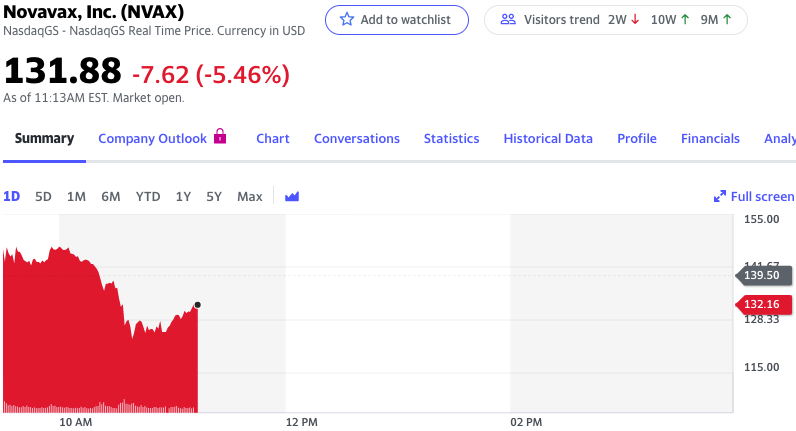
Yesterday, November 30th 2020, I sold my remaining shares of the biotech Novavax Stock at $143.53. I had previously sold shares of the stock in July at $98.29 and then regretted that sell when the stock rose to over $170 a month later. Although I expect the stock to once again rise, I decided that I was satisfied with the gains and did not want to monitor a company that had never brought a vaccine to market in its 33 year history, but received $1.6 billion dollars from the Trump Administration’s shady Operation Warp Speed.
In 2018, fresh from a divorce and having to meet new financial responsibilities of child support and thinking ahead about my son’s college fund, I opened an account with Robinhood. After all, the trading app allowed me to open an account with next to no money, unlike my experience with Vanguard with which I needed a base $3k to start investing. So I needed to generate more money and felt it was time to learn about the stock market beyond the safety of Vanguard indices.
Amongst my most speculative investments was Novavax as I know nothing about biotech, but the stock was a penny stock and I figured, why not take a small gamble. Of course, I considered the company’s long history dating back to 1995 and looked at the rise and falls of the stock. I thought to myself – it’s been around a long time, it has 500 employees, I’ll buy over hundred shares at an average of .56 cents and see what happens. Again, I was new to investing and did not have substantial funds to gamble with so I only buy small amounts, hoping that little by little, I can buy more.
On May 10th 2019, NVAX had a 1 for 20 reverse split, so for each 20 shares of NVAX that I owned pre-split, suddenly became 1. I watched my 120 shares that I had spent $72.21 become 10 stocks (yes not a 1 to 20 and I don’t understand this). Although the dollar amount remained the same, I hated seeing my over a hundred shares become 10. I was so annoyed with the stock, but oh well, nothing to do but let it sit. (The math here doesn’t add up, according to my Robinhood history, I bought 100 shares at .62 cents and then 20 shares at .51 cents and then those 120 shares became 10 following the reverse split. However, the dollar amounts below are correct.)
In the end, I spent $72.21 and sold for $1344.84 for at total gain of $1272.89. Now, I’ll take that gain and buy perhaps Apple or Google or Amazon – a stock that I expect will be around for at least ten years – this is my friend Greg’s advice – buy shares of companies that will stick around. (I’ve already bought Tesla and have only gained, but keep expecting that to entirely disappear at any moment.)
I understand that I’ll never become wealthy at this rate of playing it safe, but I elected to not be greedy and instead to be happy with this gamble, while walking away from Operation Warp Speed nonsense. By the way, yesterday, I sold NVAX at $143.53 and today it is at $125.32; after today, I’m not looking at this stock again. After spending way too much time looking at stocks over the last two years, I’m ready to stop speculating, hang up my dreams of getting rich quick and just invest in relatively safe companies, while also getting back to more meaningful use of my time.
My take away: It took a pandemic and a dirty president to turn my $72 into $1200. The money is dirty and we need to be transparent about how stocks rise and fall to help reign in financial disparity.
VOTE 2020 Find My Poll Site
If there’s one thing that the last four years of Trump have taught us, it is that we can generally do whatever the hell we want, unless of course it’s visibly criminal (police aside). And through the COVID-19 pandemic, many people have even become more brazen.
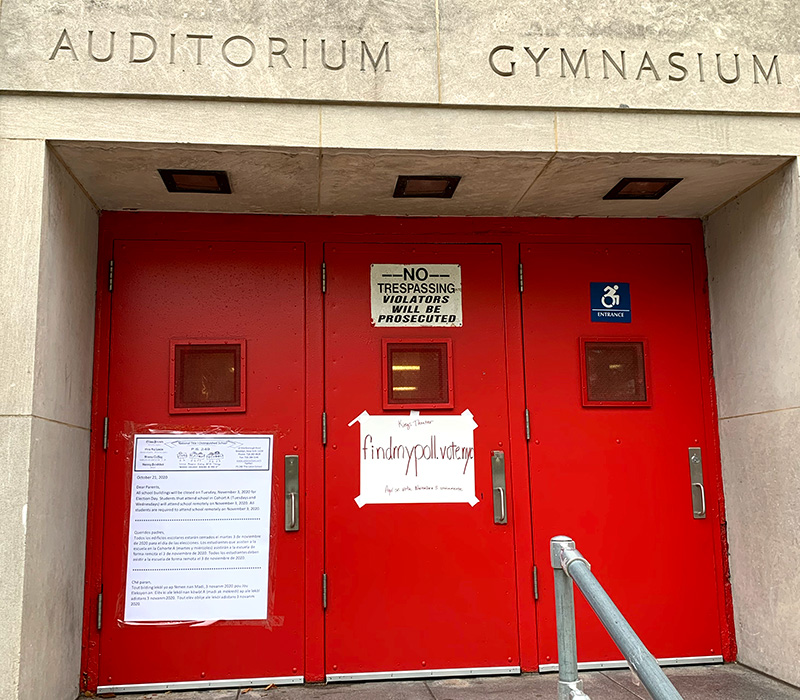
This morning, the first day of early voting for NYC – October 24th 2020 – when I saw a bunch of Caribbeans in line to vote at our usual voting site at Caton & Rugby, I told them that early voting is at Queens Theater but they all looked at me suspiciously. I repeated it loudly due to mask and physical distance three times and finally one lady engaged me, repeated what I had just old her and thanked me. However, when I walked away they remained in line. So clearly a sign was necessary. Back home, I pulled out my largest drawing paper and a fat sharpie. First I lettered in with pencil findmypoll.vote.nyc – which is wrong and I need to fix as it is findmypollsite.vote.nyc and then went over it with sharpie. And with it I retuned to the school entrance leading to the gym where voting will occur on November 3rd.
While placing a sign a man with his Caribbean accent approached me “Excuse me sir, where can I vote?” I told him Queens Theater on Flatbush and he asked “is it open tomorrow?” Not sure, I pulled out my phone searched voting site with him went to findmypollsite.vote.nyc, he gave me his address without hesitation and we saw Queens Theater come up, I was slightly relieved I had told him the right place and that it’s open tomorrow. He was grateful. And I didn’t even need to concoct a uniform!
Everyone needs to mobolize!
U.S. Data Privacy 2020
On the California 2020 ballot is Proposition 24, Consumer Personal Information Law and Agency Initiative (2020):
A “yes” vote supports this ballot initiative to expand the state’s consumer data privacy laws, including provisions to allow consumers to direct businesses to not share their personal information; remove the time period in which businesses can fix violations before being penalized; and create the Privacy Protection Agency to enforce the state’s consumer data privacy laws.
Just as California is leading the United States toward a cleaner environment, California will lead the charge toward a more just internet, one in which corporations such as FaceBook do not profiteer on our personal data. Let’s hope that this proposition moves us toward laws akin to what is in place in Europe. If anyone should monetize on ones personal data is the individual themself. VOTE YES ON PROP 24
Biden Absent as Trump Rails
I’m bracing myself for another four years of chaos. Four more years of lies, manipulation, hate, nepotism, self-interest, tax dodging, racism, tax cuts for the rich (who are better at saving than giving), market deregulation, white empowerment, pussy grabbing, virus magically gone by Easter, the phrase “shit hole countries,” separating families, putting children in steel cages, forking over millions of dollars for faulty three-mile border walls, opening precious forests to oil drilling, funding dirty energy like coal mining instead of presenting a better future, climate change denial, civil unrest, hatred…
The reason that I’m bracing myself is because the New York Times mentions Trump at least twice for any mention of Biden. I saw this during the 2016 elections – mainstream media obsessed with Trump whether positively or negatively, mentioning and covering Trump over and over. It’s like feeding the Slime Monster – whether it’s critical news or not, when only one name is mentioned, that name grows and sticks. I’ve often wondered why liberal, one-sided media channels don’t just go on a “he who must not be named” approach. We all know that any news is good news and Trump knows this better than anyone, his entire life has thrived on it. He doesn’t care if it’s negative news as any news can be spun. Most importantly he is mentioned; he who must not be named is named and his power grows.
 Biden is a senior citizen who I think would like to stay alive and is not self-obsessed, so he acknowledges the pandemic. Whereas Trump is so self-obsessed that he considers himself a demigod, immortal, perhaps a god, perhaps the Almighty himself who has been so well informed on COVID-19, that he knows that as long as he allows his germophobia guide him, he can show up in-front of large audiences in enclosed spaces without a worry. After all, his minions on an individual-basis don’t matter, so let them be dumb enough to expose themselves while Trump enjoys their adoration of him and gets headlines for brining the minions together, unmasked and inches from one another. All news is good news.
Biden is a senior citizen who I think would like to stay alive and is not self-obsessed, so he acknowledges the pandemic. Whereas Trump is so self-obsessed that he considers himself a demigod, immortal, perhaps a god, perhaps the Almighty himself who has been so well informed on COVID-19, that he knows that as long as he allows his germophobia guide him, he can show up in-front of large audiences in enclosed spaces without a worry. After all, his minions on an individual-basis don’t matter, so let them be dumb enough to expose themselves while Trump enjoys their adoration of him and gets headlines for brining the minions together, unmasked and inches from one another. All news is good news.
Trump is also incredibly talented at projecting cheesy, televisual images of grandeur. From disgustingly furnished home interiors to way too many flags in front of the White House topped off with very polished golden eagles. Trump’s motto – “if it’s gold, polish it, cause it’s mine…”


Trump is effectively capturing the ignorant, televisual imagination of the United States, while Biden Zooms to no audience. And I’m not even mentioning Pence flying around with the racist, pre-Civil Rights “Make America Great” message while Harris tries to not choke on toxic air. We are soooo screwed.

Internalized Racism
A week ago, that is the last week of pandemic June 2020, my nearly 12 year old and I biked to Clinton Hill to visit a buddy of his. The friend’s block in Clinton Hill was having a “stoop day.” We arrived at the brownstone where his friend lives in Clinton Hill on the edge of Bed-Stuy around 1pm and the next door neighbors had their stoop party rolling.
The next door neighbors are Black and they were sitting at the bottom of the stoop behind a gate drinking and talking while one man worked the grill. Parked adjacent to the next door brownstone was a large white SUV with the passenger door open and music playing; it was the sound system for the stoop. A Brooklyn summer Saturday block party was just getting started.
My son’s friend and younger brother were outside, and greeted us. The mom stepped out, we had never met so after brief introductions, I offered to escort the boys to the Christopher “Biggie” Wallace Basketball Courts around the corner. Between COVID-19 and expected rain, the courts and playground were empty. The kids threw around a football, kicked a soccer ball and we headed back to their stoop.
The mother invited us to hang out on their stoop. I took a seat and we chatted as I watched the next door party grow. With each new arrival, a small explosion of laughter and cheer – a young man with a bottle of Hennessy and plastic cups, a middle-aged woman with beer in hand… it was a multi-generational gathering. At an apartment building across the street people were setting up tables with food. I could see that rain was coming, so we didn’t stay long.
On our bike ride back, as my son and I rode next to one another in Prospect Park, he mentioned that his friend (who is White) had said that “those people party all day long.” He said it in a judgmental manner. I told him that it’s Saturday and many people work Monday through Friday, so Saturday is a day to party and enjoy family and friends. I told him that it’s a good thing as I tried to dismiss the judgmental tone.
This immediately made me consider the difference between Black and Latino cultures versus White, particularly WASP culture. I assume that my son’s judgmental tone was picked up from his friend. I recalled 15 years back seeing the summer weekend stoop parties along Vanderbilt and reading the stories of the gentrifiers calling the police to shut down those stoop parties as they loudly rolled into the evening. Now there are no stoop parties along Vanderbilt and nearly no Black people.
Then I thought about my own family in Nicaragua. On Sundays (or Saturdays), my cousins regularly head over to their parent’s homes with their families and their drink of choice – one cousin adopted Titos a few years ago, others stick to Flor de Caña and uncles tend to elect whiskey or vodka. The weekend is commonly to gather and enjoy family. The kids play while the adults talk, drink and listen to music and everyone feasts on carne asada or pollo asado, tortilla, chicharron, tostones… At the larger family gatherings, it doesn’t always end well, occasionally simmering disagreements explode, words are said, but soon enough everyone will gather again.
When I was very young, my own parents would sometimes throw weekend parties. It wasn’t every weekend as we did not have much family around, but every few weeks and it was more friends than family. As I grew older, those parties ended. My dad worked whenever he could. If someone called in sick, he’d cover. He was a BART maintenance employee for 27 years. There were periods when he’d take a second job or try to run his own janitorial company or even drive to the airport and try to pick up passengers. It seems to me that when he was younger he enjoyed life a lot more and as he grew older he became more obsessed with amassing money. Perhaps it was having a family or making sure that all bills were paid off or being comfortable when he retired or he just had a lot of energy and with a family – why not use that energy for financial security… Whichever it was, my parents were immigrants that adapted to US life and culture, one in which work, not having debt and amassing money is central. (At least for poor immigrants, commonly, not living with debt is a goal.) However, in the US there are many cultures and amongst them Black and Latino cultures are more likely to maintain the importance of weekend socializing, drinking, music and partying. Whereas WASP culture is more likely to embrace isolation, the Weekend Edition of the New York Times, reading a novel, exercising in the park, silence and contemplation. And mixed in this is a bit of work – checking emails, checking bank accounts, perhaps moving a bit of money… They are not likely to tolerate loud music and regular weekend parties.
All this said, the reason behind this reflection is my disconcert at my son’s judgmental tone at the idea of people partying all day long and underlying that judgmental tone is a trace of racism. I present two radically different measures of the value of life. One is based on productivity whereas the other on joy. One may find joy through accomplishment, the other finds joy in joy itself. One has a puritanical and protestant root with a moral basis whereas the other has “savage” root with a hedonistic basis. However, the savage hedonism has been tamed or civilized, because it is only after a week of hard work that the pursuit of pleasure for the sake of pleasure is enjoyed. And in writing this, I display my own implicit racism.
The Golden Age of FinTech

FinTech for the Precariat (working title) is a net art work that speculates on the false promises of income distribution in the Age of Bezos. COVID-19 has compounded existential insecurity; the pandemic of stress has been inseminated by the novel flu virus to birth a new reality – a chasm of uncertainty. As unemployment soars, speculative futures drive a stock market that has largely rebounded from the initial shock, but on what basis? The basis that this moment will soon pass and the age of plutocrats, technocrats and authoritarianism will continue thriving a year from now; the slight disruption soon forgotten. The agenda of economic growth must be embraced at the cost of human health. After all, those who enjoy the economic growth will remain safely at home in their condo or rural cabin or yacht.
It has been projected that the 2020s will be the decade of the FinTech Revolution. This marketing hyperbole is on the heels of many such revolutions – the Green Revolution, the Personal Computing Revolution, the dot.com, web2.0 and Social Network Revolution… These revolutions are sold on the promises of democratization and wealth. And they always leave a toll from cancer and the privatization of agriculture to unparalleled surveillance. Today financial technologies present the promise of democratizing complicated transactions, facilitating personal banking, mass speculation in stocks… Whether budgeting or gambling, these tools are relatively harmless. However, entirely new finance mechanisms or rather schemes are being developed as part of FinTech including autonomous finance, bitcoin and ultimately the financialization of human existence. A sector of FinTech will compound income inequality nationally and globally to insurmountable levels. As made abundantly clear by world leaders, finance no longer serves humanity, humanity serves finance.
The New Normal, for Now
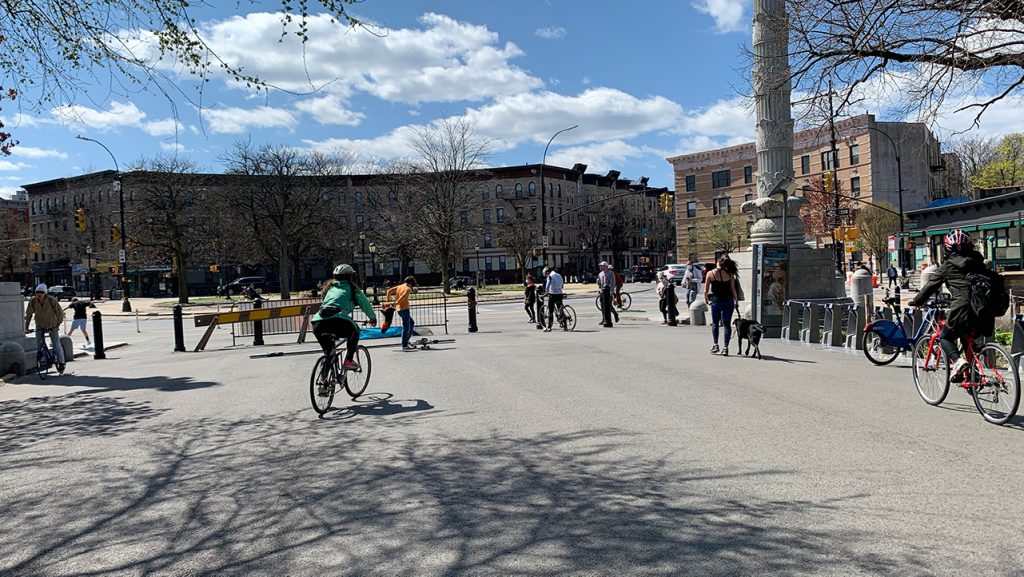
It’s the Saturday before Easter Sunday, April 11th 2020 and Prospect Park is active. Not nearly as active as on a pre-pandemic beautiful spring Saturday afternoon, but still people are jogging and cycling, some respectfully wearing masks or bandanas. Families are playing games and exercising or merely enjoying the sun. Everyone is trying to keep at least a six foot distance, however, with so much movement, it’s not always possible.
In Windsor Terrace, neighbors visit and chat from a “safe” distance. Shoppers line up around the corner from the butcher, at least six feet apart, waiting for their opportunity to shop. The liquor store has both its back door and front door open, air streams through as a sign outside instructs that only the paying customer should enter. It appears that a majority of people are wearing masks and gloves. Unfortunately, still there are many who do not, particularly the athletes. Huffing and puffing, mouth breathing runners of all shapes and ages, focus on their exercise with little consideration of those around them or the trails of breath and saliva that they leave behind. I’m no athlete, but my bike is my primary form of transportation and I wear glasses, but I still wear a mask. I recognize that I may unwittingly either catch or pass COVID-19 while getting about in public space, so although I bike in traffic and my glasses get fogged up due to the mask, I recognize that it’s the responsible thing to do.
According to the New York City’s Department of Health there are nearly 100,000 confirmed cases. 24,846 cases in Brooklyn. I assume that we all want to flatten the curve and return to a more normal existence. In a make believe world, we would all freeze in place, cocoon at home for two or three weeks and it would miraculously disappear. Of course, that is not going to happen, so why not wear a mask in public space? Throughout the history of pandemics, masks have been an essential tool to keeping viruses from moving from individual to individual, so why not wear a mask? No one likes them, no one wants to walk or run or cycle with a mask, but it seems like a small effort at this time. And it’s only for a relatively short period of time. With 25,920 people hospitalized in the city, I’m dumbfounded at why people will not wear a mask, handkerchief, or anything to cover their mouths and noses.
Since this virus will not magically disappear, this is our reality for the next several months. In the new normal, we should all exercise and enjoy the sun. We should be able to walk the streets or parks, chat with people and enjoy some sports. If we all do so thoughtfully and take appropriate precautions, including wearing masks, I believe that the new normal will be a bit more bearable. Besides, what thoughtful New Yorker wants to be a sociopath like Trump who declares that he is not wearing a mask as citizens die.
Tropicana Face Shield
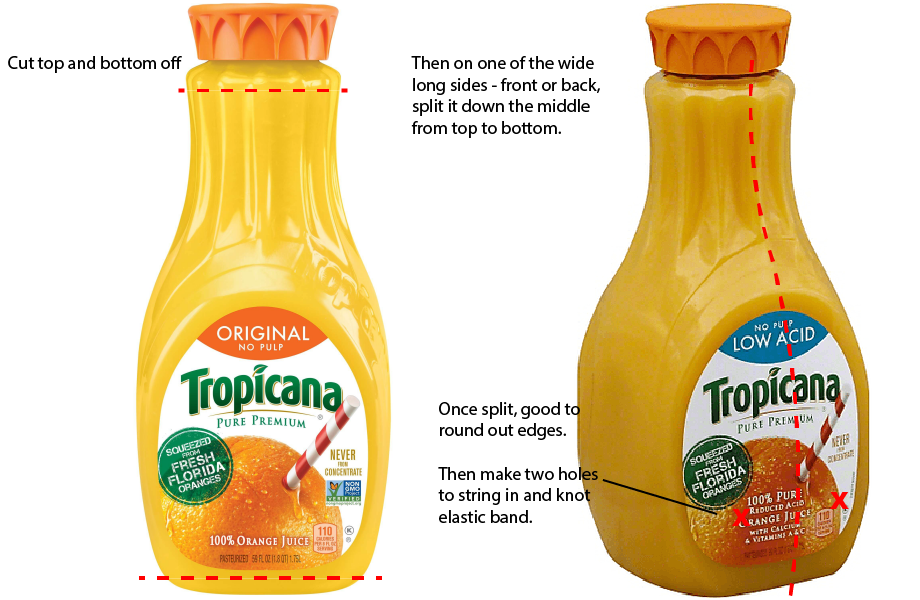
As the ease of the spread of COVID-19 becomes increasingly apparent, I decided to try and make a face shield from a commonly available product – a Tropicana bottle of orange juice. I generally do not drink juice, but recently decided to buy oj to have around for my kid. As COVID-19 exploded onto New York City, the Tropicana bottle neared emptiness. Once it all had been drunk it went into the recycling bin. At this time a friend sent me a link to DIY face shields and a call to artists to make them if they had plastic sheets. I did not have any plastic sheets. However, following a particularly alarming walk in my neighborhood, I pulled it out. I thought, who knows, rather than recycling, it may be immediately useful. Turns out that a Tropicana bottle makes for a reasonable face shield, all be it that I have no idea what the appropriate gauge is for a face shield, but hey it is solid plastic and holds liquid in.
Here’s the finished cut up Tropicana bottle as face shield. It works great to cover my entire face, but I have glasses, so it feels better to be worn below my glasses. After the initial wearing, the rubber band broke, so an elastic band works best.
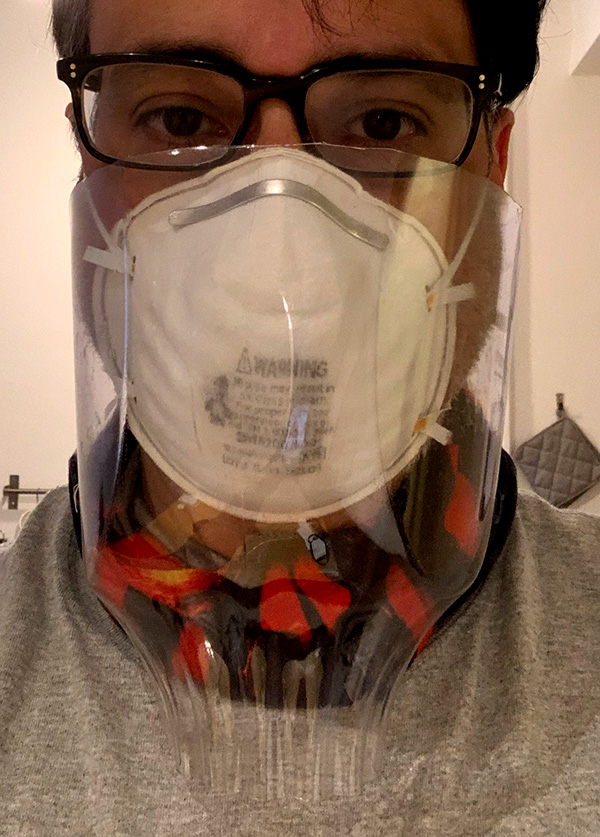
I shared a video on FB making this… https://www.facebook.com/ricardo.miranda1/videos/10102086965865719/
COVID-19 NYC Map
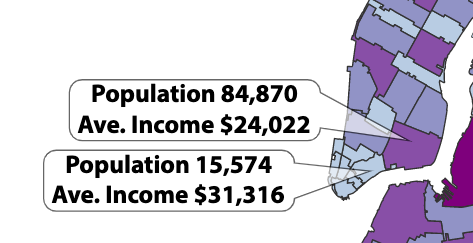
The last 24 hours I have been obsessed about comparing the COVID-19 case map that the NYC Department of Health made available with NYC population and median household income according to zip code (as the DOH map is layed out). So I added to the DOH map.
All the data is old at this point – DOH case map is two days old (March 31st). The population and income data is from the 2010 census. (I can probably find more recent income data.) But I was curious to get a sense of how these numbers compare with cases. Of course the population data presents a direct correlation – density tends to mean more coronavirus cases.
Only select zip codes have data as I was scraping it by hand. The data that is available can be toggled on and off as the map is initially (upon loading) way too crowded: http://rmz.nyc/covid/covidNYC_Map.html